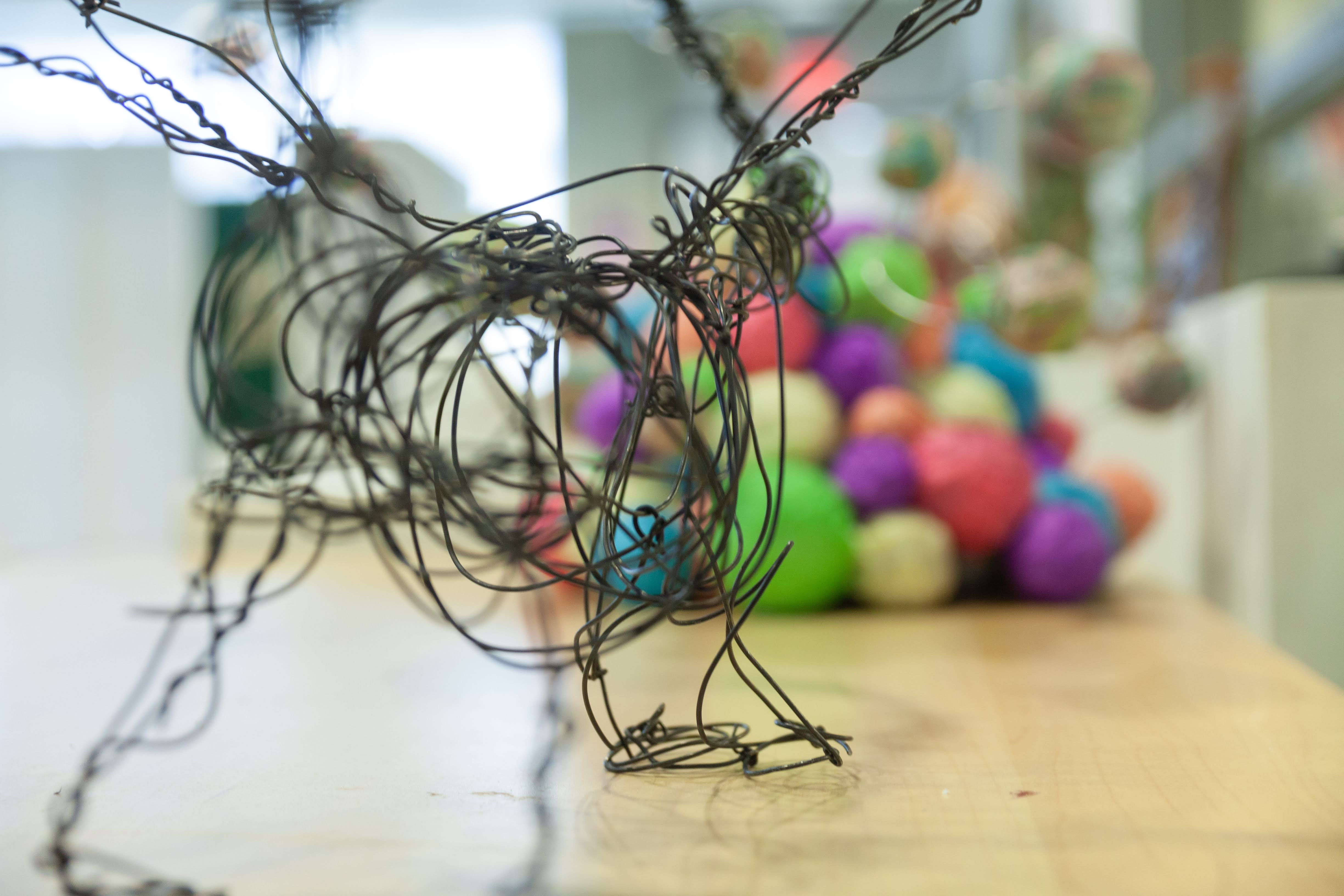Kimberly Sheridan is an Associate Professor of Educational Psychology. She received her doctorate in Human Development and Psychology in June 2006 from Harvard University Graduate School of Education. She holds a joint appointment in the College of Visual and Performing Arts.
Dr. Sheridans research takes a sociocultural perspective on learning in the arts and media, with a particular focus on how this learning is situated in diverse and changing contexts with the advent of new digital technologies. She focuses on how these can be innovative contexts of possibility for traditionally underserved groups. For 2012-2015, she is co-leading a collaborative project, Learning in the Making: Studying and Designing Makerspaces, funded by a National Science Foundation Cyberlearning grant. As Principal Investigator with Dr. Erica Halverson of University of Wisconsin-Madison, she is conducting ethnographic studies of makerspaces, emergent spaces involved in creative production that often involve youth and adults combining art, engineering and digital technologies, to understand how these communities emerge, function and evolve to support learning. Building on this ethnographic work, Drs. Halverson and Sheridan, collaborate with the Childrens Museum of Pittsburgh to conduct design experiments in the childrens museum MAKESHOP: pittsburghkids.org/exhibits/makeshop ![]() .
.
In her work from 2007-2011, as Co-Principal Investigator with Dr. Kevin Clark on the National Science Foundation grant, Game Design through Mentoring and Collaboration where traditionally underserved youth aged 8-18 from the D.C. area learn computer modeling, animation and game design through a peer mentoring and teaching process, she looks at the learning involved in the integration of art, science and technology, and the social collaborative processes involved in peer mentoring in this context. This work has continued past 2011 through the generous support of private and corporate donors. In 2011-2012, she was awarded a George Mason University creative award to collaborate with Dr. Kristien Zenkov and Dr. Supriya Bailey to use digital arts based methods to engage students in Manassas, VA and Port Au Prince, Haiti to reflect on the purposes, values and problems of school.
Prior to coming to George Mason, Kim was a research specialist at Harvard University Project Zero, where she studied the habits of mind taught and learned in intensive visual arts classes. Based on that work, she is a co-author of the book, Studio Thinking: The real benefits of visual arts education, which has been featured in articles in the New York Times and the Boston Globe, and has been influential on educators internationally, and has a 2nd edition published in 2013. She has applied this work to her research in digital arts, and to other contexts such as early childhood classrooms.
Dr. Sheridan has received a number of grants and awards, including ones from the National Science Foundation, Fulbright, Spencer Foundation and a George Mason University Creative Award. In 2010, she was invited to give a George Mason University Vision Series Lecture: Art, Science and Games: Learning in Studios. She has given keynote addresses on her work at a number of state art education associations, and has worked with the John F. Kennedy Center for Visual and Performing Arts, National Endowment for the Arts and the Corcoran Gallery of Art, and educators from Fairfax, Arlington, Loudoun and Washington D.C. to improve PreK-12 art education and arts integration efforts in the D.C. area. She is engaged in national discussions about arts learning, development, and new technologies.
Recent Publications
- Sheridan, K. M., Halverson, E.R., Litts, B., Brahms, L., Jacobs-Priebe, L., & Owens, T. (2014). Learning in the making: A comparative case study of three makerspaces. Harvard Educational Review, 84(4),505-531.
- Halverson, E.R. & Sheridan, K.M. (2014). The maker movement in education. Harvard Educational Review, 84(4), 495-504.
- Halverson, E.R. & Sheridan, K. M. (2014). Arts education and the learning sciences. In R.K. Sawyer (Ed.) Cambridge Handbook of the Learning Sciences (2nd Ed), (pp. 626-646). Cambridge University Press: Cambridge, ENG.
- Scott, K.,Sheridan, K.M. & Clark, K. (2014). Culturally Responsive Computing: A Theory Revisited. Learning, Media and Technology (ahead of print), 1-25.
- Sheridan, K. (2014). On the intelligence in children’s making. In Mind, Work and Life: A Festschrift on the occasion of Howard Gardner’s 70th Birthday: Vol. 2. (p. 277-287).
- Sheridan, K. (2014). Permission to wonder: A review of Philip Yenawine’s Visual Thinking Strategies. Teachers College Record, Date Published: January 31, 2014
http://www.tcrecord.org ID Number: 17396.
ID Number: 17396. - Sheridan, K., Clark, K., & Williams, A. (2013). Designing games, designing roles: A study of youth agency in an informal education program. Urban Education, 48(5), 734–758. doi:10.1177/0042085913491220 (pdf)
- Hetland, L., Winner, E., Veenema, S., & Sheridan, K. (2013). Studio thinking 2: The real benefits of visual arts education. (2nd ed.) Teachers College Press: New York.
- Zenkov, K. & Sheridan, K. (2012). Artistically asking about school: Picturing city youth as writers, artists, and citizens. In K. Hutzel, F. Bastos, and K. Cosier (Eds.) Urban education with a vision: Art, social justice, and the city as possibility. Teachers College Press: New York.
- Sheridan, K. & Gardner, H. (2012). Artistic development: Three essential spheres. In A. Shimamura and S. Palmer (Eds.) Aesthetic Science: Connecting Minds, Brains, and Experience. Oxford University Press.
- Khalili, N., Sheridan, K., Williams, A., Clark, K., and Stegman, M. (2011). Students designing video games about immunology: Insights for science learning. Computers in the Schools. 28(3), pp. 228-240.
- Sheridan, K. (2011). Envision and observe: Using the Studio Thinking Framework for learning and teaching in the digital arts. Mind, Brain and Education. 5(1), pp. 19-26.
- Sheridan, K., & Clark, K. (2010). Designing game design studios: Strategies to sustain intrinsic motivation. In Proceedings of World Conference on Educational Multimedia, Hypermedia and Telecommunications 2010 (pp. 2911-2920). Chesapeake, VA: AACE.
- Khalili, N., Williams, A., Stegman, M., Clark, K. & Sheridan, K. (2010). Integrating Science Content into Video Game Design. In Proceedings of World Conference on Educational Multimedia, Hypermedia and Telecommunications 2010 (pp. 2760-2764). Chesapeake, VA: AACE.
- Clark, K. & Sheridan, K. (2010). Game design through mentoring and collaboration. Journal of Educational Multimedia and Hypermedia. 19(2), pp. 125-145. (pdf)
- Scott, K.A., Clark, K., Hayes, E., Mruczek, C. & Sheridan, K. (2010). Culturally Relevant Computing Programs: Two examples to Inform Teacher Professional Development. In D. Gibson & B. Dodge (Eds.), Proceedings of Society for Information Technology & Teacher Education International Conference 2010 (pp. 1269-1277). Chesapeake, VA: AACE.
- Scott, K.A., Clark, K., Sheridan, K., Hayes, E. & Mruczek, C. (2010). Engaging More Students from Underrepresented Groups In Technology: What Happens if We Dont?. In D. Gibson & B. Dodge (Eds.), Proceedings of Society for Information Technology & Teacher Education International Conference 2010 (pp. 4097-4104). Chesapeake, VA: AACE.
- Sheridan, K., Clark, K. & Peters, E. (2009). How scientific inquiry emerges from game design. In C. Crawford et al. (Eds.), Proceedings of Society for Information Technology and Teacher Education International Conference 2009 (pp. 1555-1563).Chesapeake, VA: AACE.
- Sheridan, K. (2009). Studio thinking in early childhood. In M.J. Narey (Ed). Making meaning: Constructing multimodal perspectives of language, literacy, and learning through arts-based early childhood education.Springer: New York.
- Sheridan, K. (2008). Reading, writing and watching: The informal education of film fans. In J. Flood, D. Lapp, and S.B. Heath (Eds.) Handbook on Teaching Literacy through the Communicative, Visual and Performing Arts. (2nd ed.) Lawrence Erlbaum: Mahwah, NJ.
- Hetland, L.,Winner, E., Veenema, S., & Sheridan, K. (2007). Studio thinking: The real benefits of visual arts education. Teachers College Press: New York.
- Keinanen, M., Sheridan, K. & Gardner, H. (2006). Opening up creativity: The lenses of axis and focus. In J. Kaufman and J. Baer (Eds. ) The Relationship Between Creativity, Knowledge, and Reason. Cambridge University Press: New York. *First authorship is shared.
- Winner, E., Hetland, L., Veenema, S., Sheridan, K., & Palmer, P. (2006). Studio thinking: How visual arts teaching can promote disciplined habits of mind. In P. Locher, C. Martindale, L. Dorfman, & D. Leontiev (Eds.), New Directions in Aesthetics, Creativity, and the Arts (189-205). Amityville, New York: Baywood Publishing Company,
- Sheridan, K., Zinchenko, E. & Gardner, H. (2005). Neuroethics in education. In J.Illes (Ed) Neuroethics in the 21st Century: Defining the Issues in Theory, Practice and Policy, J. Illes (Ed.) Oxford University Press: Oxford.
- Connell, M. W., Sheridan, K. & Gardner, H. (2003). On abilities and domains. In R. Sternberg (Ed) Psychology of abilities, competencies and expertise. Cambridge University Press: New York (pp. 126-155)



